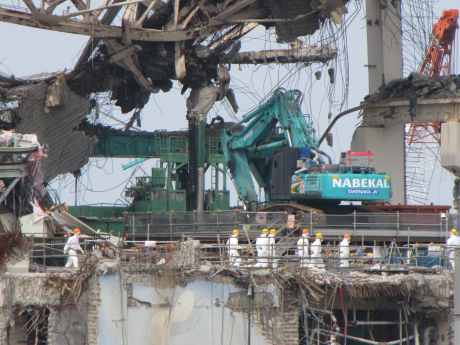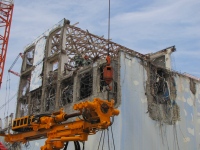Tepco has published further measurements showing that the used fuel pool at the damaged reactor building of unit 4 at Fukushima Daiichi is not tilting and would be able to withstand a large earthquake.
 |
| Japanese minister Goshi Hosono visits Fukushima Daiichi unit 4 on 28 May to see first-hand the extent of the damage and progress with work towards removing fuel from the pool (Image: Tepco) |
Tepco has released details of building tilt and strength measurements, and has concluded that the building is not tilting. Moreover, the company said, it could withstand an earthquake similar to the one which triggered the events of March 2011 which led to the reactor's destruction.
Fukushima Daiichi 4 suffered extensive damage following the Tohoku-Chihou-Taiheiyou-Oki earthquake and ensuing tsunami of March 2011. Questions were raised over the stability of the wrecked plant, and in particular the used fuel pool located at the top of the reactor building, following the observation of a bulge in the outer wall. The entire fuel load for reactor 4 is held inside the pool because the unit had already been defuelled for maintenance work when the natural disasters struck. Steel beams and concrete have been installed to support the pool, which is seen as one of the biggest hazards on the Fukushima Daiichi site.
 |
| The wrecked upper levels of Fukushima Daiichi 4 (Image: Tepco) |
Measurements based on water levels in the reactor well and used fuel pool show that the building is not tilting, while measurements of the perpendicularity of the outer wall are within acceptable building standards limits. A partial deformation has been observed on the western wall, but the location of the deformation means it would have little effect on the stability of the used fuel pool or the building as a whole, according to Tepco. The deformation is in an area with vaulted floors for hatches and elevator shafts which is assumed to have suffered major impacts from the hydrogen explosion that destroyed the top of the building.
The water level measurements alone are not sufficient to rule out the possibility of shear deformation, where the building is deformed into a parallelogram shape with the upper and lower surfaces of the building remaining parallel but the walls tilted. The absence of tilting in the exterior walls, and the lack of noticeable shear cracks, prove that this is not happening, Tepco said.
Some 97 earthquakes of magnitude 6.0 or more have already been recorded as aftershocks of the huge earthquake of 11 March 2011, according to the Japan Meteorological Agency.
Tests of strength
Tepco's observations also involved visual inspections, looking for cracks on concrete floors and walls of the used fuel pool. No cracks above 1 mm wide, or with the possibility of rebar corrosion, were found. Non-destructive testing of the used fuel pool's concrete strength confirmed that its structural strength was above the design standard.
The results confirm that Fukushima Daiichi unit 4's used fuel pool remains safe and can safely hold used fuel, Tepco concluded. The company has also added extra reinforcement beneath the pool to improve its seismic margins still further, and has confirmed that the thickness of the pool's walls remains sufficient for their purpose even though some parts of the upper exterior walls are damaged.
Future inspections will take place to monitor any changes in the situation, Tepco said.
Researched and written
by World Nuclear News




_47120.jpg)

_23621.jpg)






